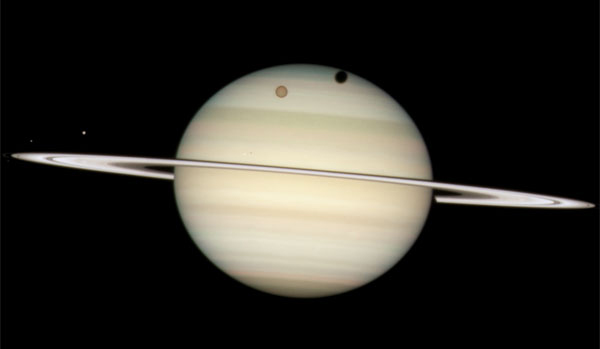|
|||||||||||||||||||
|
Saturn photo-op demonstrates Kepler observation technique
(PLANETQUEST) -- As the Kepler planet-finding mission lifted off into space last month, the planet Saturn and its retinue of moons were giving astronomers a preview of the phenomenon that the spacecraft will use to find Earth-like worlds beyond our solar system. Every 14 to 15 years, Saturn's rings are positioned almost "edge-on" as viewed from Earth, allowing for a clear, unobstructed view of the planet. From this vantage point, both professional and amateur observers can watch as Saturn's many moons pass in front of the planet, events known as transits. The Hubble Space Telescope took the opportunity to snap a photo of this rare phenomenon, resulting in some spectacular images that show the orange color of Titan's hazy nitrogen atmosphere and its dark shadow against Saturn's otherwise bright cloud tops. Kepler will also be looking for transits -- ones that occur when an extrasolar planet passes between its host star and the Earth. As a planet moves in front of its star, it blocks some of the light traveling in the direction of Earth. This causes a slight dimming effect that Kepler's sensitive optics can detect and measure. These measurements can tell astronomers about the size of a planet and the distance it orbits from its host star. The Kepler mission will monitor thousands of stars at the same time, watching for the telltale changes in starlight that indicate the presence of an exoplanet. From these results, scientists hope to determine the frequency of habitable planets like ours in the galaxy. The window to see Titan passing directly in front of Saturn has passed, but observers will still be able to see Titan's shadow against Saturn several more times this year, starting April 29. Other shadow transit dates (all times are times are GMT):
Written by Joshua Rodriguez/PlanetQuest
|
||||||||||||||||||||||||||||||||
Privacy/Copyright |
Site Map |
Feedback |
Glossary |
Awards & Credits |
For Educators |
For Press |
Widgets |
|
|



